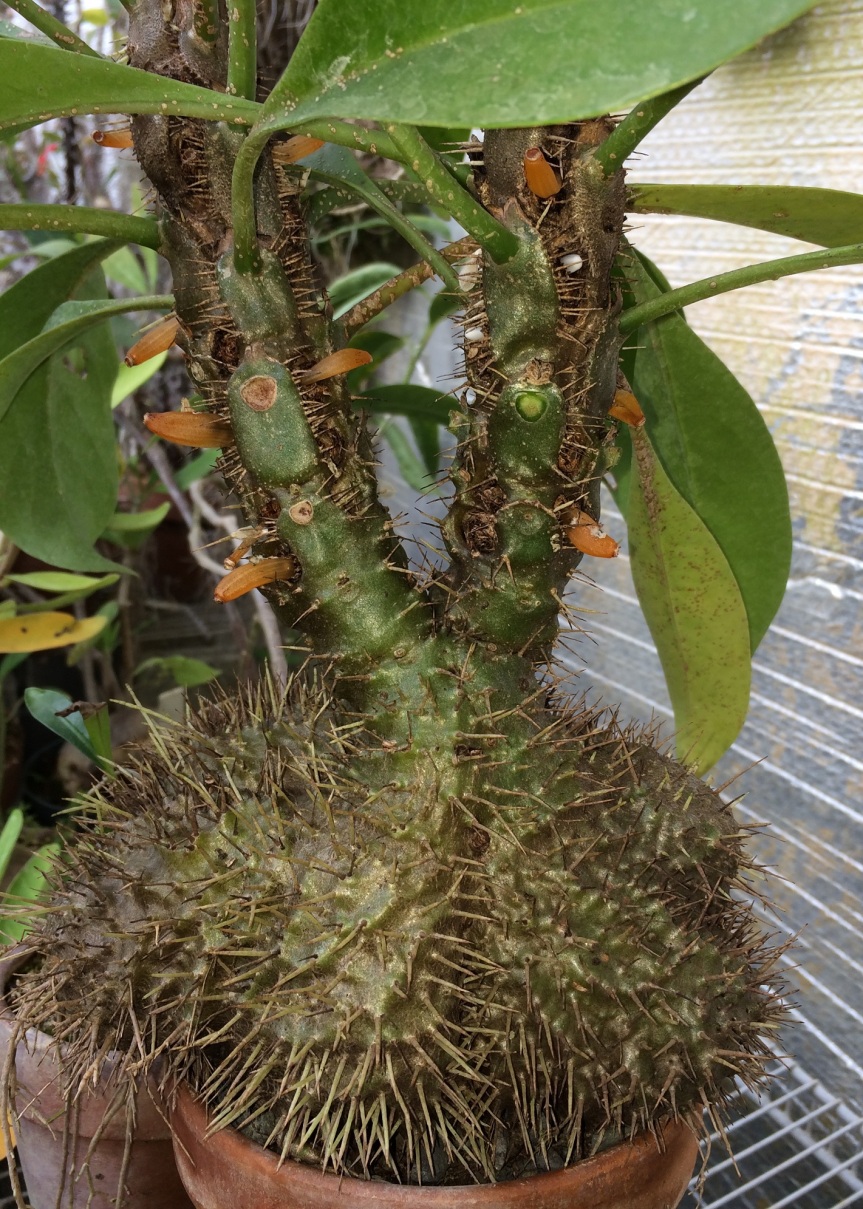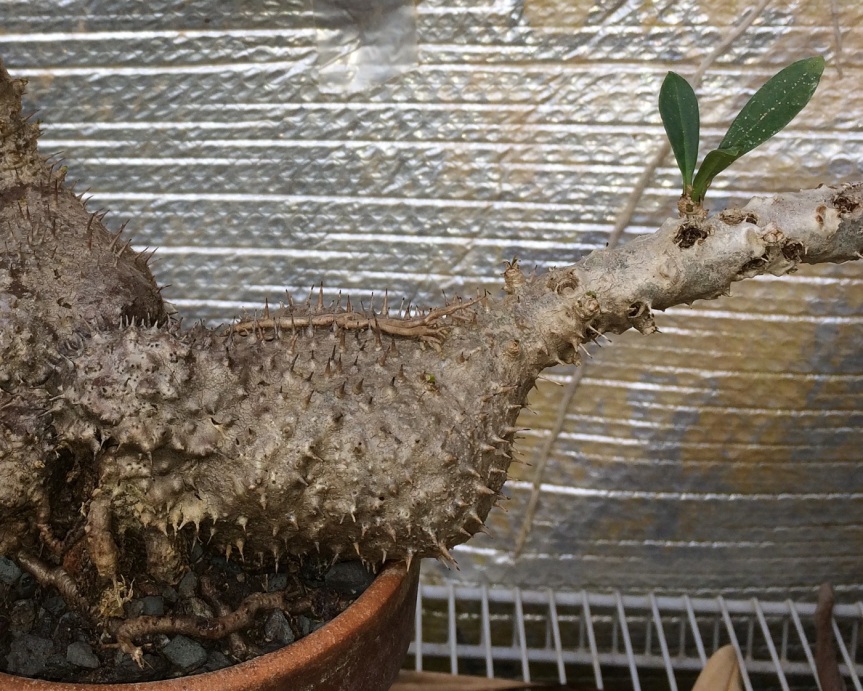After a couple of weeks absence, here’s another Six on Saturday. As with previous posts on Pachypodium and Nepenthes, I’m focusing on a single group of greenhouse plants this week.

The epiphytic myrmecophytes (ant plants) of the coffee family, Rubiaceae, are surely some of the strangest plants that grow anywhere in the world. Their overall appearance is often grotesque: gray or silver or brown blobs with thick, armored stems and sharp spines derived from modified roots. They cling to tree trunks or hang upside down below horizontal branches, looking like aliens that have inexplicably settled in an Asian forest. And to top all of that, their real strangeness is hidden inside. Soon after a seedling ant plant germinates, the hypocotyl–the stem below the cotyledons–starts to swell into a tuber. As the plant grows, tissue within the tuber dies in a genetically programmed manner, first forming a hollow space and then expanding into a series of tunnels and chambers. The tunnels are connected to the outside by entrance holes around the base of the tuber, and the chambers are often aerated by pores.
All of this baroque development is for the benefit of symbiotic ant colonies who set up housekeeping in the artificial nest that the plant has grown. Both insects and plant benefit from the relationship. The ants get a secure home, and the plant is fed by the ants. The ants live in smooth-walled chambers and deposit leftover fragments of insect prey and other waste in chambers with wart-like excrescences on the walls. As the waste decomposes, the plant absorbs nitrogen through the warts.


The natural range of the rubiaceous ant plants extends from Thailand to Australia and east as far as Fiji, but the greatest diversity is found on New Guinea. In the mid-1990s, when I first became interested in ant plants, only about five species were in cultivation, and they were very hard to find. With some effort (i.e. obsessive searching), I managed to connect with a few other like-minded growers via email and traded seed and seedlings with the curators of several botanical gardens. These days, the plants are (somewhat) easier to obtain, and a wider range of genera and species are in cultivation thanks to the efforts of a handful of hobbyists and nursery owners from around the world. Several nurseries in Europe and the U.S.A. sell seedlings, and plants are occasionally available on eBay.
So without further ado, here are six (on Saturday) ant plant species:
1. Myrmecodia platytyrea (Mossman Gorge form)
The plant shown at the top of this post is a very vigorous Myrmecodia descended from material originally collected in northern Queensland. Like most of the rubiaceous ant plants in cultivation, M. platytyrea has flowers that self-pollinate, so seedlings remain true to type over multiple generations. The Mossman Gorge form of M. platytyrea produces long, sharp spines and very vigorous roots that often invade the pots of its neighbors. Its leaves are narrower and more succulent than other cultivated M. platytyrea descended from plants collected in New Guinea.

The shield-like leaf bases on the stems of M. platytyrea are called clypeoli. The spines bordering the clypeoli hide alveoli, pits in which the small white flowers develop and from which the orange fruit protrudes when ripe.
2. Myrmecodia sp. “Pink Fruit”

This species has very strong sharp spines and pink fruit. It is commonly cultivated by ant plant enthusiasts, but its origins are obscure. Possibly, it is M. tuberosa ‘Papuana’ which grows in New Guinea and northern Australia.
3. Myrmecodia tuberosa


This is the most variable and widespread Myrmecodia species, with a range extending from Malaysia to Australia. The form shown here does not have strongly developed clypeoli, so you can easily see the elongated alveoli filled with papery bracts.
4. Myrmephytum beccarii

Myrmephytum is a genus of five species found in the Philippines, Sulawesi, and western New Guinea. M. beccarii is from the Philippines, and was introduced into cultivation in the U.S. around 2006.
5. Hydnophytum moseleyanum

H. moseleyanum is a lowland species from New Guinea and Australia. Hydnophytum species usually lack spines and have many elongated branches without clypeoli and alveoli. Their chambers are less complex than those of Myrmecodia. Note the large entrance hole on the side of this tuber. Above and left of the entrance hole, a patch of papery dead tissue is peeling away to reveal a new hole.
6. Hydnophytum formicarum
A very variable and widespread lowland species from Thailand, Malaysia, and Indonesia. Several different forms varying in size and color are in cultivation.



So, that’s six rubiaceous myrmecophytes. For more Six on Saturday that is perhaps a little less botanically grotesque, head over to The Propagator.

A group of plants I’ve not heard of before and stand no chance of ever growing but totally fascinating to learn about. Something to read more about to fill those long, cold, winter evenings we’re about to get hit with. I think I’ll start a “Plants I Want to Read About” list to accompany the “I want” list (which I’ve now frozen at 23 for next year). Thanks for this six.
LikeLiked by 1 person
That’s a good idea, and less expensive than the want-to-buy list—although there’s always a risk of plants moving from one list to the other.
I’m hoping that other blogs will give me ideas for plant books to read when the weather is grotty. A series of short book reviews might be a good idea for a winter Six on Saturday.
LikeLike
I have a dim recollection of crossing the Mossman river on a rather dodgy ferry. There’s a lot of weird stuff in Australia but I didn’t see any of those. Truly fascinating.
LikeLiked by 1 person
Botanically grotesque! Ha ha. I always learn so much from your posts. Fascinating stuff!
LikeLiked by 1 person
Those are totally UGLY! I can see why you are so fascinated with them!
LikeLiked by 1 person
Wow never seen or heard of these plants before not even in the glasshouses over here in the uk, totally amazing and thank you for opening my eyes to them!
LikeLiked by 1 person
Those are truly butt-ugly plants! Fascinating though. I always find it mindbending to imagine the evolutionary process that results in such symbiotic relationships.
LikeLike
That’s a large part of their appeal. It is completely mindboggling. I would suspect the tuber originated as a water storage organ, and ants probably sheltered underneath, since nesting sites would be limited in the trees. The existing ant plants vary in the complexity of their chambers, so one can almost envision some of the intermediate steps.
LikeLike
Utterly fascinating! Thank you so much for introducing me to something I never knew of!
LikeLiked by 1 person
Very cool. I’d heard of plants which encourage ants to hang around but this is a whole new level. Evolution is incredible!
LikeLiked by 1 person
Completely different! That’s what six on saturday is all about.
LikeLiked by 1 person
Very interesting Six! I have never heard of these plants either and the documentation and the stuff are fascinating. . Why am I answering today? … because of your last six (9-12) on the books. For me, as French, none of them I can read … so I went back to the past to discover your blog 😀
LikeLike
I’m glad you liked the post. I will enjoy following your blog too.
LikeLiked by 1 person